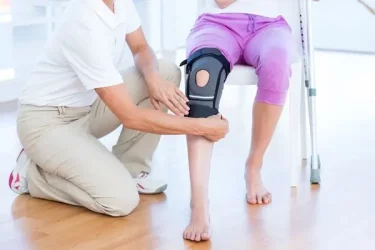Are you too young to have arthritis and knee pain? Are you too old to have a joint replacement? Is running good for your knees?
If stiff and painful knees are making stairs difficult, or pain keeps you awake at night, you may need a knee replacement. Leaving treatment too long can lead to a slower recovery.
Our dedicated article explores the most common myths about knee pain, analysing the signs you may need a knee replacement and the various treatment options.

Types of knee pain
The knee is one of the most complex joints in the human body and as such, can be more susceptible to injury. Bursitis, arthritis, ligament tears, or even infections can all cause different types of knee pain in different parts of the joint. Whether it’s pain in the kneecap, the back, or the side of the knee, the information below aims to provide insight into the different causes and what to do if you’re struggling.
Chronic knee pain
There are many potential causes of chronic pain. These can range from the following issues:
- tendonitis
- torn/sprained ligament(s)
- dislocation of the kneecap
- arthritis (osteo or inflammatory e.g. rheumatoid
- bursitis
- referred pain in the knee from other parts of the body (e.g. hip).
Treatment will depend on the specific issue. You should consult your doctor if your pain persists for more than a few weeks.
Arthritis
There are a number of signs that can point to arthritis being the cause of knee pain. These include:
- pain worsened by prolonged periods of being stationary
- stiffness of the knee
- locking/giving way of the knee
- knee crunching/grinding sounds.
Meniscus knee pain
The most common symptoms are:
- swelling
- knee locking
- joint pain, usually located on the inside, outside, or back of the knee.
Throbbing knee pain
Throbbing is typically a sign your knee is inflamed. You should consult a doctor if knee throbbing persists.
Pain while bending the knee
This can be the result of a whole host of different causes. These can include:
- repetitive use resulting in strain
- sport injuries
- arthritis.
You should consult a doctor if pain persists for more than a few weeks.
Knee pain while walking
Pain when walking can be the result of a whole host of issues. Arthritis, ligament tears, or even infection can be diagnosed as causes. Icing your knee a few times a day can help to reduce the level of inflammation, but the best course of action is consult your doctor.
Pain behind the knee
Sometimes called posterior knee pain, the causes can include:
- arthritis
- meniscus injury
- cysts
- general wear and tear
- overuse
- infection.
As with pain in other parts of the knee, you should seek medical advice if the issue persists.
Pain on the inside of the knee
This can be an indicator of:
- arthritis
- ligament damage or tears
- damage to the cartilage (meniscus).
The Medial Collateral Ligament (MCL) runs up the inside of the knee and helps to keep the joint stable. Damage to this ligament can cause pain severe enough to interfere with everyday chores and activities.
Pain in the kneecap
Pain in the kneecap (or patella) can present in different ways. For instance, it can be a dull ache or it can give way or lock. Pain is usually localised at the front of the knee. You may experience discomfort when rising from a chair and difficulties when kneeling. Some people with kneecap pain also experience a crunching or clicking sound. The causes of patella pain are numerous, ranging from overuse to muscle imbalances in the leg.
You should seek medical advice from a doctor if you experience ongoing kneecap pain.
Knee pain causes
From overuse to rheumatoid arthritis, there are a wide range of causes when it comes to knee pain.
The sportier ones amongst us will know all about the joys of a knee injury. Problems with cruciate ligaments are fairly common, especially among more active people. They typically occur following sharp, twisting movements and can take a long time to heal.
Osteoarthritis is most often attributed to ageing or simple overuse, whereas rheumatoid arthritis is caused by the body’s own immune system attacking the tissue.
If you’re experiencing persistent pain, don’t hesitate to get in touch for medical advice.
Knee pain diagnosis
During a consultation with one of our knee specialists, he or she will carry out a number of examinations and tests. This will likely range from a physical assessment to questions about your medical history. Don’t be put off by any of this! It’s simply protocol for our specialists to build a picture of your current health and identify the issue.
Depending on the nature of your issues, he or she may recommend an x-ray, MRI, or CT scan for further investigation. These are available at a number of our locations across the UK.
Knee pain symptoms
Knee symptoms can present in various ways and are typically led by the underlying issue. For example, one of the most common symptoms of a torn ligament are pain, swelling, and a sensation of giving way.
How to help knee pain
The most effective way to treat aching knees depends on what the issue is. However, there are a few things you can do to help manage any pain you might be experiencing. You never know, some of the advice below may even alleviate the discomfort!
Lose weight – maintaining a healthy weight will help to take the pressure off your knee joints. So, if you’re overweight and are experiencing knee discomfort, consider ways in which you can make lifestyle changes to shed the pounds!
RICE – this is an old one but no less effective. If you’re struggling to get around, rest, ice, compression, and elevation can work wonders. All you need is an ice pack (or a bag of frozen peas will do!), a knee support, a pillow, and a good book or Netflix show!
Seek medical advice – if your pain persists for more than a few weeks, you should see a doctor. Our knee consultants are ready and willing to help, just give us a call or fill in an online form to get things started.
Knee pain relief
Some types of knee pain can be relieved (albeit temporarily) by over-the-counter medication. For others, the RICE method or physiotherapy will be effective. Persistent pain should be addressed by a professional.
Knee pain treatment
The most effective way to treat knee pain depends on what the issue is. Anti-inflammatory and painkiller medication may help issues that lead to swelling, whereas some cases will only be fixed through surgery. Below, we investigate the ins and outs of the different ways to treat knee pain.
Injections for knee pain
If you’re experiencing persistent or a specific type of pain, injections may be effective. These are typically in the form of steroid injections. Injections are usually a short-term solution and typically last for around a few months. Your doctor will be able to recommend if this is the best course of action.
Physiotherapy
Physiotherapy can be an effective way of managing (and in some cases solving) knee pain. However, the effectiveness of treatment will depend on the type of pain you’re experiencing.
Exercises
As with physiotherapy, exercises can be an effective way of managing pain and improving overall knee health. You should, however, bear in mind that the efficiency of knee exercises will depend on the type of issue you have. For exercises to be effective, you should seek the advice of a physio who can tailor a specific treatment plan to your needs.
Stretching
Keeping limber and staying loose is a very good idea to promote the general health of your muscles and joints. It’s worth bearing in mind though that while regular stretching is a good idea, it won’t stop you from getting injured. You should consult a physio or doctor for a tailored list of effective stretches.
Surgery for knee pain
If all conservative methods have proved ineffective, your doctor may recommend knee surgery. This is usually as a last resort or if you have severe knee pain. The type of surgery you need will depend on the specific issue you have. Ask your doctor for more information about what to expect and how to prepare for surgery.
Knee pain support FAQs
Not yet found what you’re looking for? Our dedicated FAQs might be able to help!
If your knee pain has persisted for a few weeks without getting any better, you should see a doctor.
During a consultation, a doctor will likely perform a physical assessment. He or she may also carry out x-rays or scans to determine the issue.
There are a number of potential causes of knee pain without injury. Perhaps the most common is general wear and tear that comes with ageing. If your knee pain persists or you’re concerned, you should see a doctor.
This is possible but it depends on the issue. For example, a partially torn ligament will heal on its own after a few weeks of rest, but arthritis of the knee will not resolve itself. See a doctor if you’re experiencing persistent knee pain.
This depends completely on the specific issue. Minor knee pain can be treated using the RICE method (Rest, Ice, Compression, Elevation) which may solve the issue. More serious issues may require further investigation and, ultimately, more serious solutions such as surgery.
Most arthritic knee pain starts on one side of the knee (mostly on the inner side). As wear and tear gets worse, it eventually spreads to other parts of the knee joint. Often, arthritis is associated with a cyst behind the knee. This may then cause swelling and pain in the back of the knee.
Ultimately, only you will know the answer to this question. Generally, if you’ve had worsening knee pain for a few weeks, you should see a doctor. Likewise, if your knee pain is stopping you from carrying out daily activities and chores, seek the advice of a specialist.
This depends on the specific issue. For example, a partially torn ligament will likely heal on its own after a few weeks of rest. However, osteoarthritis of the knee is unlikely to improve and if left untreated, could lead to increased pain and a total loss of knee function.
The most common answer to this is severe osteoarthritis. This is because when the cartilage wears away, knee movement is bone rubbing on bone. With that said though, knee ligament tears are no walk in the park either. A full ligament tear can be extremely painful and take a long time to recover from.
The answer depends on the type of knee issue you have. New studies show that walking can help reduce pain experienced by people suffering from knee osteoarthritis. However, people with ligament tears would likely be better off resting their knee. If you’re experiencing knee pain, talk to your doctor about a treatment plan and your next steps.







